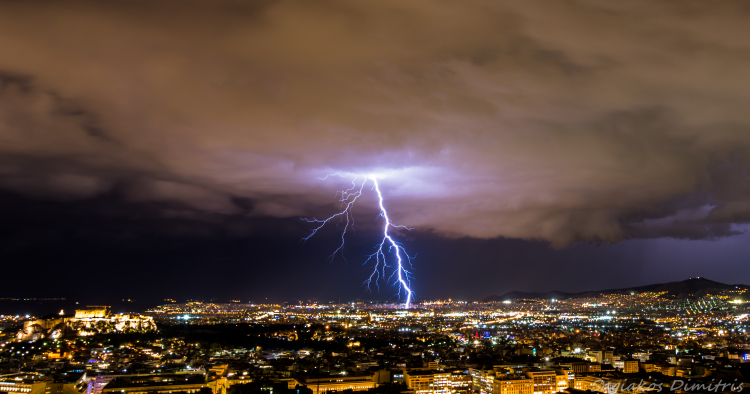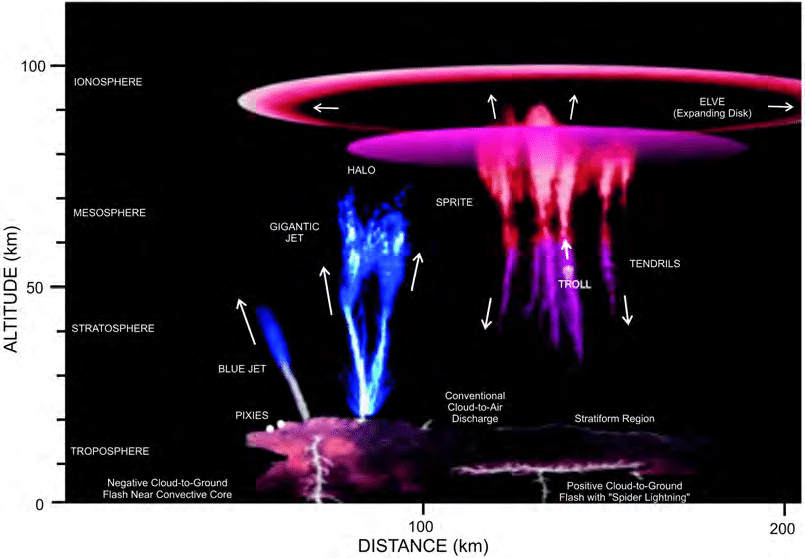A Closer Look at Lightning: Above and Below
Published: June 13th, 2025
The sounds of summer are often those of kids racing across sunlit fields, canoes gliding through a warm lake, the distant hum of lawnmowers and the sizzle of backyard cookouts. But in many parts of the world, these golden afternoons can change in an instant. Towering clouds roll in and overtake the midday sun, before lightning slices across the sky with a boom that sends swimmers, yard-workers, and families scrambling for shelter.
Lightning is one of the signature threats of thunderstorms. In the summer, storms tend to arrive suddenly and sometimes last only a few minutes, but the threat of lightning lingers. According to the National Lightning Safety Council, June through August marks the peak time for both lightning activity and outdoor recreation in the United States— and lightning strike victims are most often engaged in outdoor leisure, particularly in or near water, when they are struck (1). From baseball games to mountain hikes, from afternoon picnics to sunset boat rides, summer puts more people in lightning’s path. And yet many don’t realize just how far a lightning bolt can travel—more than 25 miles from a storm’s rainfall—or how unpredictable a strike can be even after the rain seems to have passed (2).
To better protect ourselves during this active, storm-prone season, it helps to both understand and respect lightning not just as a weather hazard, but as a complex electrical process. Lightning takes many forms, some easily recognized and others discovered only recently, and it can pose a serious threat even under blue skies. By looking more closely at the science behind lightning, we not only gain safer habits, but we begin to appreciate thunderstorms as more than just a summertime disruption.
Lightning Explained

Accessed fromUSRA.
Lightning is an enormous spark of electricity in the atmosphere produced by imbalances between storm clouds and the ground, or within the clouds themselves. These imbalances develop when ice particles within a thunderstorm collide and generate charge separation: positively charged particles gather at the top of the cloud while negatively charged particles sink to the bottom. When the difference in electrical charge becomes too great, nature corrects the imbalance with a lightning bolt (3). The National Oceanic and Atmospheric Administration reports that lightning strikes the ground an average of 25 million times per year in the United States. While the odds of being struck in any given year in the U.S. is 1 out of 1.2 million, the consequences can be devastating. On average, lightning causes 20 fatalities annually in the U.S., and hundreds more suffer serious injuries (4).
Not all lightning strikes the ground. Several distinct types of lightning exist, each with their own characteristics. In fact, some aspects of lightning are invisible to the naked eye!
Cloud-to-Ground (CG) Lightning
This is the most familiar type of lightning: a brilliant bolt cracking downward from the clouds to the Earth. Most of these flashes are negative CG strikes, which begin with an invisible “stepped leader,” or a channel of negative charge moving toward the ground. As it nears the surface, positive streamer channels surge upward, typically from tall structures like buildings or trees in the area, and when the positive and negative channels meet, the result is a fierce “return stroke,” or the visible flash we experience as lightning. Less common but often more powerful are positive CG strikes, which originate from the tops of storm clouds and consist of a single, intense return stroke—unlike the multiple, branched strokes seen in negative CG strikes. This single stroke often carries a stronger and more sustained electrical current. Because of their higher intensity and longer flash duration, positive CG lightning strikes are more likely to damage structures and spark wildfires (3,5).
Intra-Cloud (IC) Lightning
By far the most common type, IC lightning, otherwise known as cloud flashes or horizontal lightning, stays within the sky and never reaches the ground. Sometimes these flashes are hidden from view or seen only as diffuse flickers that illuminate the sky with a sheet-like glow, hence another nickname, “sheet lightning.” IC lightning occurs between oppositely charged regions within the same cloud. Similar types of lightning that don’t reach the ground are cloud-to-air (CA) lightning and inter-cloud, i.e. cloud-to-cloud (CC) lightning. These sorts of lightning can provide a dazzling sight to behold. But keep in mind that any thunderstorm has the potential to produce CG lightning strikes, so the first sign of lightning or thunder should prompt us to head indoors (5).
No matter how beautiful or brief a summertime thunderstorm may seem, we should always take lightning seriously. The best way to stay safe is to plan ahead so we can act quickly if we see a flash or hear any thunder. If we can hear thunder, we can be struck by lightning, because that means lightning is striking no more than 10 miles away from us. On the other hand, if we see flashes of lightning in the distance but hear no accompanying thunder, that means the thunderstorm is too far away for the sound of thunder to reach us. Many people refer to this soundless lightning as “heat lightning,” but that term is a misnomer. What we’re seeing is the lightning of a distant thunderstorm and its reflection off the clouds above it (6), and since lightning can strike up to 25 miles from its parent storm, it’s safest to stay indoors until we can no longer hear or see any thunder or lightning. If you’re ever unsure when to seek shelter from a thunderstorm, the National Weather Service (NWS) recommends the simple rule “when thunder roars, go indoors,” and more ways we can reduce our lightning risk on their Lightning Safety Tips and Resources webpage.
Transient Luminous Events

Accessed fromResearchGate.
While most eyes remain fixed on the dramatic bolts below, lightning has a more elusive side that plays out far above the thunderstorm. High in the upper atmosphere exists a rare family of electrical phenomena. Largely invisible to the naked eye and still only partially understood, these are transient luminous events, or TLEs:
Sprites are the most commonly documented TLE. They occur in the mesosphere, roughly 30-60 miles above the surface, and tend to discharge simultaneously with positive CG lightning strikes. Sprites appear as large, weak flashes of red light and often have a tendril-like structure that resembles a jellyfish. Because sprites emit a faint red glow that only lasts a few seconds, they are captured at night with highly sensitive cameras — while it can happen, they are seldom seen with the naked eye (5).
Blue Jets and Gigantic Jets also occur above thunderstorms, where they shoot upward in a narrow cone shape to about 25-35 miles high in the atmosphere. They appear blue because the lightning’s discharge excites nitrogen molecules in the stratosphere, which emit a blueish light in response (7). Gigantic jets extend even further toward space, reaching the ionosphere in a matter of milliseconds. While blue jets and gigantic jets are not directly linked to CG lightning, they are still a result of strong electrical activity in the thunderstorm. This type of TLE is most often seen by pilots or captured by specialized instruments aboard the International Space Station (5,7).
Elves are extremely brief and faint flashes that occur high in the ionosphere above areas of active CG lightning. They form as expanding rings, or discs, of light that can reach up to 300 miles wide! Elves are triggered by the electromagnetic pulse (EMP) from a strong CG lightning strike below. In the 2000s, researchers discovered that elves are associated with terrestrial gamma ray flashes, or TGFs. TGFs are quick bursts of high-energy radiation that were once believed to come exclusively from deep space, but when satellites designed to detect cosmic gamma rays began picking up signals that actually came from Earth, a revelation followed that thunderstorms were the surprising source. Elves glow red, but are so brief, faint, and far away that they remain invisible to the naked eye (5).
Alongside more familiar TLEs like sprites and jets, researchers have identified several other rare and whimsically named phenomena—such as trolls, pixies, and halos—that flicker above thunderclouds (figure 2). These fleeting flashes are a vivid reminder of how much we have yet to learn about the intricate and often hidden electrical activity that takes place above our heads.
Final Thoughts
The lightning we see during a thunderstorm is only part of the story, and it remains one of the most dangerous, fascinating, and underestimated elements of our planet’s weather. While researchers around the world have made great progress in understanding how and why it occurs, there is still much to learn. So, as the days grow long and we head outdoors in search of adventure, always check your local forecast for thunderstorms and other weather hazards, remember the NWS lightning safety tips, and keep watching the skies!
References
- “A Detailed Analysis of Lightning Deaths…” National Lightning Safety Council
- “Learning Lesson: Determining distance…” NOAA JetStream
- “Dr. Lightning’s Guide to Lightning…” NOAA Safety
- “Lightning Safety Tips and Resources” NOAA Safety
- “Severe Weather 101: Lightning Types” NOAA National Severe Storms Laboratory
- “Heat Lightning” NOAA Safety
- “Space station detectors spot the source…” Science News
- Figure 1, “Positive Cloud to Ground Lightning…” Universities Space Research Association
- Figure 2, “Artist impression of lightning and other TLEs” ResearchGate

